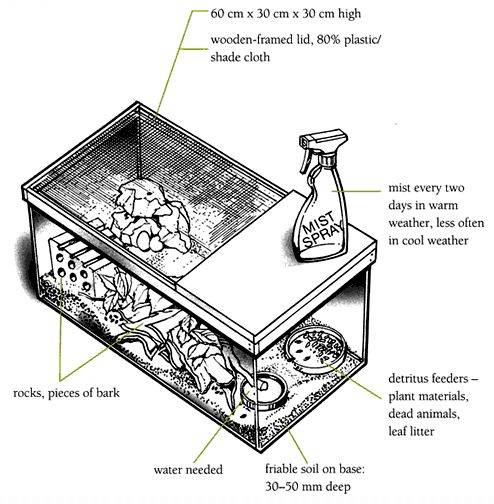You are here:
- Home »
- Teaching science »
- Caring for animals in the classroom »
- Slaters
Slaters
Housing
The tank
- Slaters need a glass tank 60 centimetres × 30 centimetres × 30 centimetres high with a wooden or steel lid, 70 percent of which is covered with plastic or steel insect mesh or shade cloth for ventilation.
- On the base, provide friable soil 30–50 millimetres deep and mounded to assist drainage.
- Provide a few rocks so that the slaters can climb off the soil and some places for them to hide. Pieces of rotten wood, bricks, or stones in layers will provide very thin spaces for slaters to creep into. Some species of slaters prefer to shelter in large groups and are attracted by other individuals, so their shelter should be large enough for this to occur.
Environment
- A dark, well-ventilated part of the room away from sunlight is the best site for the slater enclosure.
- Slaters can survive at room temperatures of 10–20°C, but they are not very tolerant of temperatures above this. The average should be 14–18°C.
- Humidity levels are also important. These can vary from 50 to 70 percent, but the space under the shelter should be only slightly damp. You can obtain the correct humidity levels within the enclosure by misting every second day during dry weather and every fourth or fifth day in cool and/or damp weather. Once the enclosure is set up, the slaters will move into the areas that best suit their feeding or resting requirements.
Tank diagram
- room temperature range 10-20°C
- keep in dark, well-ventilated area

Slaters tank: main features
Tank diagram explanation
A glass tank measuring 60cm x 30cm x 30cm high is shown with a wooden framed lid which is three quarter plastic or shade cloth.
The cage should be kept in a dark well-ventilated area.
There is a mist bottle on top of the cage to denote misting every two days in warm weather, less in cooler weather.
On the tank floor there are rocks and pieces of bark and friable soil 30–50cm deep.
Slaters are detritus feeders and need plant materials, dead animals and leaf litter in the a feeding lid.
Room temperature range for slaters 10–20°C.
How to care for slaters
Feeding
- Slaters are detritus feeders, eating mainly plant materials but also scavenging on dead animals. Good-quality leaf litter in the enclosure will provide a source of readily available food.
- Slaters will also feed on tender seedlings, dried fish food (flakes), or soaked cat biscuits. Place these in an upturned lid.
- Replace the leaf litter regularly, taking care not to remove the slaters themselves.
- Pay particular attention to the condition of the leaf litter. This must include leaves in different degrees of decomposition because slaters can be selective about the state of decay of the leaf litter that they eat.
- Provide water for drinking in a shallow lid no deeper than 10 millimetres and replenish it daily.
Copyright
The text and illustrations for this online edition of Caring for animals: A Guide for teachers, early childhood educators, and students (published on Te Kete Ipurangi for the New Zealand Ministry of Education in 2005) is copyright © Crown 2005. All rights reserved.
Content has been adapted for the web from the printed version, originally published in 1999 by Learning Media Limited for the Ministry of Education. Although no longer available this publication may still be available in some schools.

